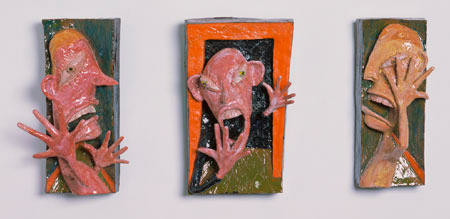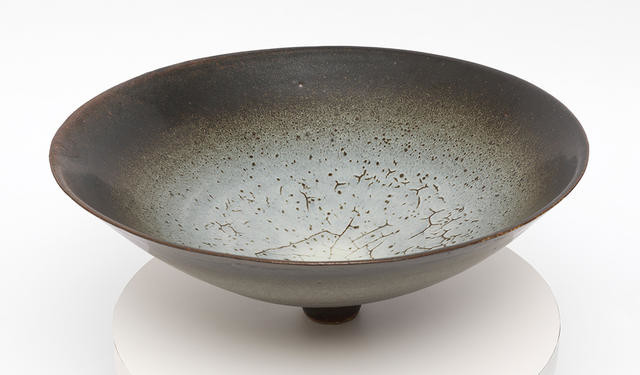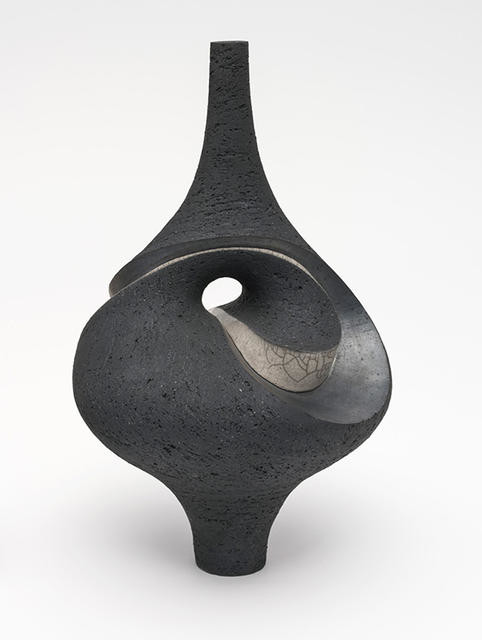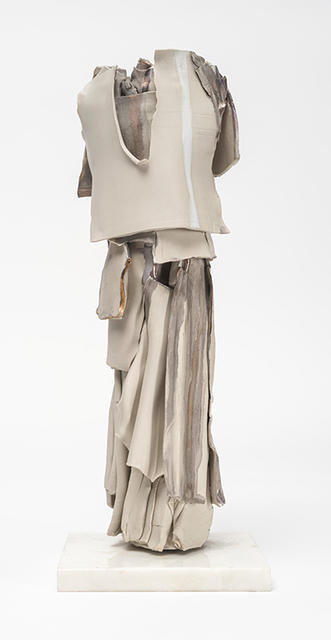B.
The Ceramic Collection
Collection
The Gallery's ceramic collection underwent a remarkable shift during the 1980s, in both the way ceramics were regarded and in the number of works collected. However, some of the first pieces to be acquired were purchased in 1954 and 1955. They were early works by the New Zealand master ceramic artist, Len Castle (b.1924), made in 1956-7 before he went to Cornwell to study with Bernard Leach (1887-1979). Inspired by Leach and the Japanese ceramic artist Shoji Hamada (1894-1978), Castle developed an individual oeuvre that drew upon his love of the natural environment and his fascination with the symbol of the circle. Bowl Stemmed (1985), an elegant wheel - thrown bowl with a rich crackle glaze and refined stem, reflects Castle's Anglo-Japanese aesthetic and his highly developed technical skill in kiln firing.
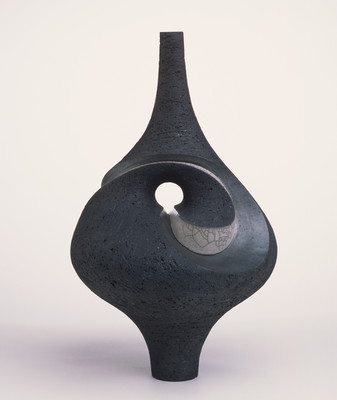
Rick Rudd Raku No. 915 1986. Pinched, coiled and raku fired ceramic. Collection of Christchurch Art Gallery Te Puna, o Waiwhetū, purchased 1988. Reproduced with permission
During the 1970s under the directorship of Brian Muir and with the advice of potter and CSA Director Nola Barron, the collection began to expand, including work by Mirek Smisek, Juliet Peter, Barry Brickell, Roy Cowan and David Brokenshire. Nola Barron was an early member of the Canterbury Potter's Association, formed in 1963, to co-ordinate the common interests of potters in the Canterbury and West Coast regions. Other pioneers of ceramics include Doreen Blumhardt who published, in collaboration with Brian Brake, New Zealand Potters - Their Work and Words in 1976. The Collection also contains a significant number of ceramics by unknown Japanese artists, ranging from fired clay funerary figures and utilitarian earthenware, all generously gifted to the Gallery in 1969 and 1974 respectively, by Christchurch's sister city, Kurashiki.
Organised through the Potter's Association, Hamada and Leech visited New Zealand, (Leach visited in 1962, Hamada in 1965 and 1973). Their presence influenced a generation of New Zealand potters and cemented the Japanese influence of simple and unassuming wheel thrown pots, which stressed a restrained quality. In 1965, Hamada brought with him a major exhibition which was shown at the Canterbury Museum. He worked with potter Yvonne Rust in her studio and gave many seminars and lectures as well as sharing his glaze recipes with potters during his first visit. Other international ceramic artists to come to New Zealand included Harry and May Davis, who arrived from England in 1962, settling in Nelson, and the English potter Michael Cardew who was Guest Artist for the 1968 Arts Festival.
Since the first emphasis on Japanese aesthetics styles have changed toward a wider diversity of techniques and individual expression. By the 1980s the Collection began to focus on the sculptural three-dimensional qualities of ceramics rather than the functional domestic-ware that had dominated the market. Drawing on his experience of New Zealand native bush, James Greig, a student of Len Castle's, developed the idea of a 'growth form' pot. Many of his pieces were hand built sculptural forms emblematic of Greig's concerns for nature and the cyclic processes of transformation that occur within the earth. A figurative emphasis is seen in the work of Polish/Australian ceramist Maria Kuczynska, who was Guest Exhibitor for the 1984 Christchurch Festival Pottery Exhibition. Her porcelain sculpture, Standing Figure, exudes an archaic quality reminiscent of Classical Greek sculpture. Although fragmented, the folded porcelain evokes a bodily presence of contained energy, at once monumental and fragile.
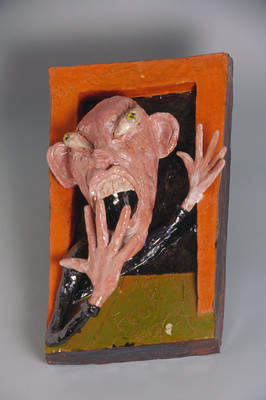
Jimmy Cooper A Spot of infidelity (detail) 1996. Earthenware. Collection of Christchurch Art Gallery Te Puna o Waiwhetū, purchased 1997
The range of expression achievable through this medium, from the traditional to the experimental, can be seen in Rick Rudd's Raku No. 915 (1986) and in narrative works such as Jimmy Cooper's triptych, A Spot of Infidelity (1996). A traditional technique, raku fired clay originated in China during the 10th century and was refined by Japanese potters during the 16th century. Removed from the kiln with tongs while red-hot and placed in sawdust or other combustible material, the clay is smoked to create a chalky black, textured surface. Rudd's Raku No. 915, a pinched and coiled organic form, also has a burnished crackle glaze detailing the inner curve of the mobius twist (the intrinsic structure of the vessel) with a distinct earthy-beige colour. In contrast, Cooper's A Spot of Infidelity, recalls a single dramatic moment through three earthenware panels. Projecting out from the wall, they are sculptural and three dimensional with painterly and slightly abstracted coloured glazes. In its vivid colour, exaggerated expressions and sense of drama, this work is also suggestive of comic book art.
Contemporary ceramic artists continue to push the boundaries of the medium, in both decorative and sculptural genres. Prestigious awards such as Faenza in Italy, the Sidney Myer Fund International Ceramics Award and the Fletcher Challenge Award, celebrate the versatility of this practice. A selection of the Gallery's ceramic collection will be on display in the Christchurch Art Gallery's Monica Richards Gallery in 2003. Entitled Essential Forms it will also include textiles and glass art, many of which will be on public display for the first time since their acquisition into the Collection.
Jennifer Hay
